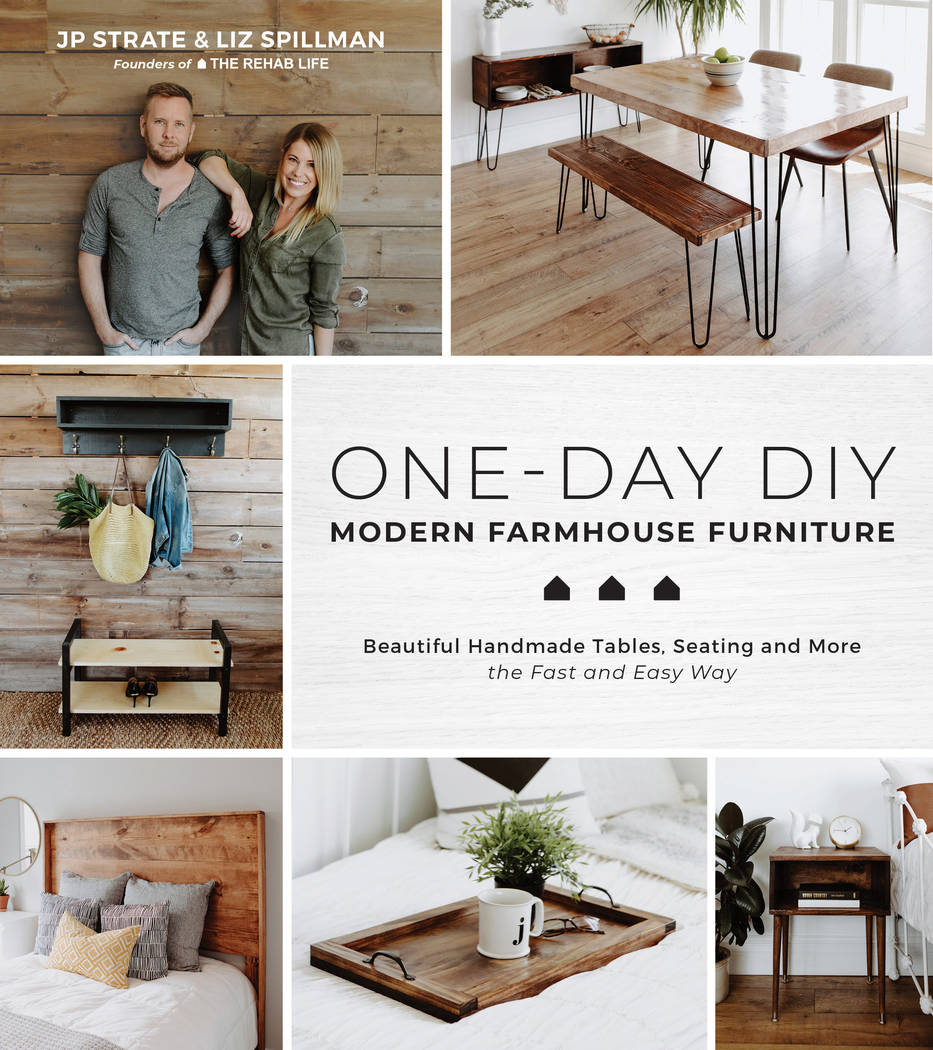New DIY book highlights ‘modern farmhouse’ style
J.P. Strate and Liz Spillman have taken to heart the adage, “If you want something done right, do it yourself.”
Years ago, the pair, who are professional house flippers in the Minneapolis-St. Paul area, needed furniture to stage their remodeled abodes in preparation for sale.
Rather than purchase pricey pieces, they used simple tools to create trendy farmhouse-style coffee tables, benches, nightstands and such.
They are convinced that others can — and should — do the same.
In 2015, Strate and Spillman founded The Rehab Life, a popular YouTube channel that boasts over 245,000 subscribers. It features detailed supply lists and demonstrates step-by-step instructions for re-creating their furniture and design projects — from cutting wood planks with a miter saw and distressing pieces to achieve a well-worn look, to placing the finished products in spaces.
Piggybacking off the channel’s success, the longtime friends wrote their first book, “One Day DIY: Modern Farmhouse Furniture” (Page Street Publishing), a how-to guide for handcrafting nearly two dozen furniture and accent pieces.
Spillman and Strate frequently receive comments from viewers of The Rehab Life who brim with pride after building an item featured in one of its videos.
“That’s really satisfying to us to see all of the people who would never normally get into woodworking using our channel and making those cool projects and just being so excited about it,” she said.
The book focuses on modern farmhouse-style furniture, which Spillman explained is a departure from the traditional farmhouse-style furniture that she and Strate have previously created.
The farmhouse aesthetic, which is characterized by charmingly weathered and otherwise distressed pieces, has exploded in popularity in recent years courtesy of such downhome-design experts as Joanna Gaines, co-star of the former HGTV series “Fixer Upper.”
“I think that the kind of overarching thing about farmhouse style is that it’s functional and it’s simple. I think you can make that work anywhere,” Spillman said.
However, she said, “We’ve definitely seen a (design) trend going away from that really rustic farmhouse look. We’re not beating up our furniture anymore.”
In the book, they incorporated sleek metal hairpin legs on tables and benches, cleaner, straighter lines and other updated design elements.
“We used a lot of hairpin legs so that the house would have a running theme if you did want to build all of the projects in the book,” Strate said. “The coffee tables match the dining room table, which matches the bench and the console table so that it looks like a cohesive house.”
The simple, bent-metal legs are “super easy and they’re pretty inexpensive. You can get them on Amazon,” Spillman added. “They’re really easy to attach and they’re strong. … We had always used wood (legs) in the past and we found (hairpin legs) online and were like, ‘Wow, this is a great way of changing a piece of furniture.’ You can take it from rustic farmhouse (style) to modern farmhouse easily and quickly.”
Another popular project in the book is a sliding barn door that Strate said is far easier to build than it seems at first glance.
“That was one of the quickest projects that we did,” he said.
It requires four sheets of medium-density fiberboard (MDF), available at most big-box hardware stores, as well as a drill and other household tools, some hardware and paint.
Because the door is large, do-it-yourselves will need a little extra space to construct it, Strate said. “But it’s no more difficult than any of the other builds (in the book),” he added.
Barn doors are also uber-trendy, according to Tanya Kash, president of Cloud 9 Interiors (which does business as Decorating Den Interiors) in Las Vegas.
“I get asked to do barn doors (in designs) all the time, even … in completely modern homes,” she said. Her clients “love the elements of that farmhouse design.”
Kash is a fan of both the “casual” traditional and modern farmhouse styles, although “it’s definitely not for everybody,” she said.
“I think that there’s a lot more textures that they’ve introduced … for a more modern style (with) cleaner lines. … Some of the basics are there. It’s wood, it’s concrete, it’s all of the elements that you would find in a country setting.”
Although the idea of building furniture may seem intimidating, Strate said there’s no reason for novices to be nervous.
“I think people will see all of these instructions (in the book) or just (related to) woodworking in general and think, ‘Oh, I can’t do that,’ but there are a lot of things you can make with just a few simple hand tools and a saw,” he said. “A lot of the larger home improvement stores will actually cut the wood for you, so you’re already a few steps ahead in the project. … Basically, you just need to assemble it.”
By following the instructions, he said, it is also possible to prevent projects from looking homemade. For example, wood filler can be used to hide screw holes. Meanwhile, a coat of polyurethane can provide pieces with a showroom-quality shine.
“Things like that give the product a more vintage look rather than having a bunch of screws showing or wood that’s dull,” Strate said.
Besides, Spillman reminded, farmhouse-style furniture isn’t meant to look perfect.
“There’s dents and nicks, and maybe the stain is a little bit darker on one edge than the other edge,” she said. “It adds charm and it’s rustic, so even if you mess up, you generally can make it work.”





















